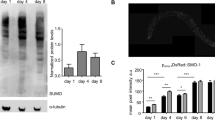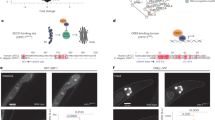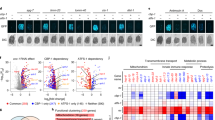Abstract
Activating AMPK or inactivating calcineurin slows ageing in Caenorhabditis elegans1,2 and both have been implicated as therapeutic targets for age-related pathology in mammals3,4,5. However, the direct targets that mediate their effects on longevity remain unclear. In mammals, CREB-regulated transcriptional coactivators (CRTCs)6 are a family of cofactors involved in diverse physiological processes including energy homeostasis7,8,9, cancer10 and endoplasmic reticulum stress11. Here we show that both AMPK and calcineurin modulate longevity exclusively through post-translational modification of CRTC-1, the sole C. elegans CRTC. We demonstrate that CRTC-1 is a direct AMPK target, and interacts with the CREB homologue-1 (CRH-1) transcription factor in vivo. The pro-longevity effects of activating AMPK or deactivating calcineurin decrease CRTC-1 and CRH-1 activity and induce transcriptional responses similar to those of CRH-1 null worms. Downregulation of crtc-1 increases lifespan in a crh-1-dependent manner and directly reducing crh-1 expression increases longevity, substantiating a role for CRTCs and CREB in ageing. Together, these findings indicate a novel role for CRTCs and CREB in determining lifespan downstream of AMPK and calcineurin, and illustrate the molecular mechanisms by which an evolutionarily conserved pathway responds to low energy to increase longevity.
This is a preview of subscription content, access via your institution
Access options
Subscribe to this journal
Receive 51 print issues and online access
$199.00 per year
only $3.90 per issue
Buy this article
- Purchase on SpringerLink
- Instant access to full article PDF
Prices may be subject to local taxes which are calculated during checkout




Similar content being viewed by others
References
Apfeld, J., O’Connor, G., McDonagh, T., DiStefano, P. S. & Curtis, R. The AMP-activated protein kinase AAK-2 links energy levels and insulin-like signals to lifespan in C. elegans . Genes Dev. 18, 3004–3009 (2004)
Dong, M. Q. et al. Quantitative mass spectrometry identifies insulin signaling targets in C. elegans . Science 317, 660–663 (2007)
Steinberg, G. R. & Kemp, B. E. AMPK in health and disease. Physiol. Rev. 89, 1025–1078 (2009)
Supnet, C. & Bezprozvanny, I. Neuronal calcium signaling, mitochondrial dysfunction, and Alzheimer’s disease. J. Alzheimers Dis. 20 (suppl. 2). 487–498 (2010)
Shackelford, D. B. & Shaw, R. J. The LKB1–AMPK pathway: metabolism and growth control in tumour suppression. Nature Rev. Cancer 9, 563–575 (2009)
Conkright, M. D. et al. TORCs: transducers of regulated CREB activity. Mol. Cell 12, 413–423 (2003)
Liu, Y. et al. A fasting inducible switch modulates gluconeogenesis via activator/coactivator exchange. Nature 456, 269–273 (2008)
Screaton, R. A. et al. The CREB coactivator TORC2 functions as a calcium- and cAMP-sensitive coincidence detector. Cell 119, 61–74 (2004)
Koo, S. H. et al. The CREB coactivator TORC2 is a key regulator of fasting glucose metabolism. Nature 437, 1109–1111 (2005)
Komiya, T. et al. Enhanced activity of the CREB co-activator Crtc1 in LKB1 null lung cancer. Oncogene 29, 1672–1680 (2010)
Wang, Y., Vera, L., Fischer, W. H. & Montminy, M. The CREB coactivator CRTC2 links hepatic ER stress and fasting gluconeogenesis. Nature 460, 534–537 (2009)
Crute, B. E., Seefeld, K., Gamble, J., Kemp, B. E. & Witters, L. A. Functional domains of the α1 catalytic subunit of the AMP-activated protein kinase. J. Biol. Chem. 273, 35347–35354 (1998)
Leffler, A. et al. The vanilloid receptor TRPV1 is activated and sensitized by local anesthetics in rodent sensory neurons. J. Clin. Invest. 118, 763–776 (2008)
Wang, W. & Shakes, D. C. Expression patterns and transcript processing of ftt-1 and ftt-2, two C. elegans 14-3-3 homologues. J. Mol. Biol. 268, 619–630 (1997)
Kostelecky, B., Saurin, A. T., Purkiss, A., Parker, P. J. & McDonald, N. Q. Recognition of an intra-chain tandem 14-3-3 binding site within PKCε. EMBO Rep. 10, 983–989 (2009)
Johnson, C. et al. Bioinformatic and experimental survey of 14-3-3-binding sites. Biochem. J. 427, 69–78 (2010)
Kimura, Y. et al. A CaMK cascade activates CRE-mediated transcription in neurons of Caenorhabditis elegans . EMBO Rep. 3, 962–966 (2002)
Mayr, B. & Montminy, M. Transcriptional regulation by the phosphorylation-dependent factor CREB. Nature Rev. Mol. Cell Biol. 2, 599–609 (2001)
Xiao, X., Li, B. X., Mitton, B., Ikeda, A. & Sakamoto, K. M. Targeting CREB for cancer therapy: friend or foe. Curr. Cancer Drug Targets 10, 384–391 (2010)
Urano, F. et al. A survival pathway for Caenorhabditis elegans with a blocked unfolded protein response. J. Cell Biol. 158, 639–646 (2002)
Haskins, K. A., Russell, J. F., Gaddis, N., Dressman, H. K. & Aballay, A. Unfolded protein response genes regulated by CED-1 are required for Caenorhabditis elegans innate immunity. Dev. Cell 15, 87–97 (2008)
Viswanathan, M., Kim, S. K., Berdichevsky, A. & Guarente, L. A role for SIR-2.1 regulation of ER stress response genes in determining C. elegans life span. Dev. Cell 9, 605–615 (2005)
Greer, E. L. et al. An AMPK-FOXO pathway mediates longevity induced by a novel method of dietary restriction in C. elegans . Curr. Biol. 17, 1646–1656 (2007)
Jansson, D. et al. Glucose controls CREB activity in islet cells via regulated phosphorylation of TORC2. Proc. Natl Acad. Sci. USA 105, 10161–10166 (2008)
Erion, D. M. et al. Prevention of hepatic steatosis and hepatic insulin resistance by knockdown of cAMP response element-binding protein. Cell Metab. 10, 499–506 (2009)
Shaw, R. J. et al. The kinase LKB1 mediates glucose homeostasis in liver and therapeutic effects of metformin. Science 310, 1642–1646 (2005)
Qi, L. et al. Adipocyte CREB promotes insulin resistance in obesity. Cell Metab. 9, 277–286 (2009)
Lerner, R. G., Depatie, C., Rutter, G. A., Screaton, R. A. & Balthasar, N. A role for the CREB co-activator CRTC2 in the hypothalamic mechanisms linking glucose sensing with gene regulation. EMBO Rep. 10, 1175–1181 (2009)
Hope, I. A. C. elegans: A Practical Approach (ed. Hames. B. D.) (Oxford Univ. Press, 1999)
Fire, A. et al. Potent and specific genetic interference by double-stranded RNA in Caenorhabditis elegans . Nature 391, 806–811 (1998)
Mair, W. A simple yet effective method to manipulate C. elegans in liquid. Worm Breed. Gaz. 18, 33 (2009)
Gentleman, R. C. et al. Bioconductor: open software development for computational biology and bioinformatics. Genome Biol. 5, R80 (2004)
Affymetrix. GeneChip Expression Analysis 〈http://www.coriell.org/images/pdf/expression_manual.pdf〉 (Affymetrix, 2004)
Wu, Z., Irizarry, R. A., Gentleman, R., Martinez-Murillo, F. & Spencer, F. A model-based background adjustment for oligonucleotide expression arrays. J. Am. Stat. Assoc. 99, 909–917 (2004)
Smyth, G. K. Linear models and empirical Bayes methods for assessing differential expression in microarray experiments. Stat. Appl. Gen. Mol. Biol. 3, article 3. (2004)
Benjamini, Y. & Hochberg, Y. Controlling the false discovery rate: a practical and powerful approach to multiple testing. J. R. Stat. Soc. B 57, 289–300 (1995)
Kel, A. E. et al. MATCH: a tool for searching transcription factor binding sites in DNA sequences. Nucleic Acids Res. 31, 3576–3579 (2003)
Matys, V. et al. TRANSFAC and its module TRANSCompel: transcriptional gene regulation in eukaryotes. Nucleic Acids Res. 34, D108–D110 (2006)
Benbrook, D. M. & Jones, N. C. Different binding specificities and transactivation of variant CRE’s by CREB complexes. Nucleic Acids Res. 22, 1463–1469 (1994)
Bucher, P. Weight matrix descriptions of four eukaryotic RNA polymerase II promoter elements derived from 502 unrelated promoter sequences. J. Mol. Biol. 212, 563–578 (1990)
Acknowledgements
W.M. is funded by the George E. Hewitt Foundation for Medical Research, the American Federation for Aging Research and the Glenn Foundation for Medical Research. R.J.S. is funded by National Institutes of Health (NIH) R01 DK080425 and P01 CA120964. A.P.C.R. and G.M. are funded by NIH R01 HG004164, AG031097 and CA14195. A.D. is supported by NIH R01 DK070696 and AG027463. We thank the Caenorhabditis Genetics Center, the National Bioresource Project for the Nematode and Mark Alkema for providing worm strains. We are grateful to M. Raices and M. D’Angelo for critical analysis of the manuscript, DAPI images and the NUP-160::GFP construct. We also thank members of the A.D. laboratory and M. Hansen for comments on the manuscript and discussion and K. Butler for technical assistance in the early stages of this project.
Author information
Authors and Affiliations
Contributions
W.M., I.M., M.M., R.J.S. and A.D. designed the experiments. W.M. and I.M. performed the experiments. A.P.C.R analysed the microarray data and performed the promoter analysis and W.M. analysed and performed statistical analysis on all other data. The manuscript was written by W.M. and edited by I.M., A.P.C.R., G.M., R.J.S. and A.D. All authors discussed the results and commented on the manuscript.
Corresponding authors
Ethics declarations
Competing interests
The authors declare no competing financial interests.
Supplementary information
Supplementary Information
The file contains Supplementary Figures 1-15 with legends and Supplementary Tables 3 and 4 (see Separate files for Supplementary Tables 1, 2 and 5). (PDF 14949 kb)
Supplementary Table 1
This table displays normalized expression measurements for all probesets. (PDF 24514 kb)
Supplementary Table 2
This table displays differentially expressed genes in each of the three mutants relative to wild-type. Each row correponds to a probeset, so a gene may appear in multiple rows. Also, reported are GO functional categories associated with each gene and CRE and TATA motifs identified upstream of each gene, the notation used follows the key: Hit Score | Palindromic | Hit Position | Hit Location in Genome | Distance to TSS | Conservation in other Caernohabditis. (XLS 2318 kb)
Supplementary Table 5
This table displays survival data and statistics for life span experiments. (XLS 16 kb)
Rights and permissions
About this article
Cite this article
Mair, W., Morantte, I., Rodrigues, A. et al. Lifespan extension induced by AMPK and calcineurin is mediated by CRTC-1 and CREB. Nature 470, 404–408 (2011). https://doi.org/10.1038/nature09706
Received:
Accepted:
Published:
Issue Date:
DOI: https://doi.org/10.1038/nature09706
This article is cited by
-
Role of sestrins in metabolic and aging-related diseases
Biogerontology (2024)
-
Calcineurin stimulation by Cnb1p overproduction mitigates protein aggregation and α-synuclein toxicity in a yeast model of synucleinopathy
Cell Communication and Signaling (2023)
-
The CRTC-1 transcriptional domain is required for COMPASS complex-mediated longevity in C. elegans
Nature Aging (2023)
-
Refeeding-associated AMPKγ1 complex activity is a hallmark of health and longevity
Nature Aging (2023)
-
Glycerol 3-phosphate phosphatase/PGPH-2 counters metabolic stress and promotes healthy aging via a glycogen sensing-AMPK-HLH-30-autophagy axis in C. elegans
Nature Communications (2023)



